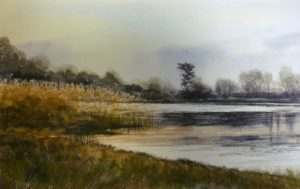
This watercolour – completed from a photograph taken early in the morning in March 2017 at one of my favourite locations – Castle Howard in North Yorkshire. From this side of the great lake you can look up to the right to make out the house in the distance. The heads of the reeds catching the sun on the left was a striking effect against the dark background of the distant trees. The different tonal values reflecting of the surface of the water made for added interest.
1 Working on Arches 300gsm NOT surface Watercolour Paper stretched by stapling onto a sheet of MDF. Started by faintly sketching the layout with a 4b pencil. Then soaking the
Working on Arches 300gsm NOT surface Watercolour Paper stretched by stapling onto a sheet of MDF. Started by faintly sketching the layout with a 4b pencil. Then soaking the
paper with water and adding varying amounts of Yellow Ochre to certain areas while still
wet and bringing in some Cerulean Blue in to the sky. Using the SAA Artists’ watercolour paints for this particular piece.
2 A mixture of Yellow Ochre, Burnt Umber, Ultramarine and Paynes Grey added over the distant trees, darker parts of the lake and the foreground. While still wet, added much more pigment to distinguish between the darker and the lighter values. Actually adding much more pigment than you think necessary as the colour dulls as it drys.
3 Force-dry with a hairdryer – this drastically reduces drying time allowing to work quickly, this enables the entire painting to be completed in under 1 hour.
4 Picking out details such as visible branches in the distance. Also going over the very darkest values on the surface of the water. A natural sponge comes in handy to give the suggestion of the very faintest branches on the distant trees. You don’t want to paint every single branch – using the sponge is a quick and effective way of adding watercolour to achieve this effect. Remember- Try it out on a scrap piece of paper before going straight on to your painting surface to avoid unnecessary mistakes!
Picking out details such as visible branches in the distance. Also going over the very darkest values on the surface of the water. A natural sponge comes in handy to give the suggestion of the very faintest branches on the distant trees. You don’t want to paint every single branch – using the sponge is a quick and effective way of adding watercolour to achieve this effect. Remember- Try it out on a scrap piece of paper before going straight on to your painting surface to avoid unnecessary mistakes!
5 For the foreground adding Sap Green and Crimson to previous mixture. Applying plenty
of pigment to increase the intensity of the colour as moving closer to the foreground. Remember to leave some parts lighter to emphasise texture as much as possible.
6 Now to pick out individual reeds and stems in the foreground using the darkest mixture
of pigments. In addition, it is possible to see the stems of the reeds sticking up out of the
water in the middle distance. Using an SAA Silver Rake Brush for this part of the process. Dry.
7 Nearly there. Finally, using a blade to scratch out a few highlights on the surface of the water and some foreground stems – just to make the painting ʻpopʼ. And it’s done!
Nearly there. Finally, using a blade to scratch out a few highlights on the surface of the water and some foreground stems – just to make the painting ʻpopʼ. And it’s done!